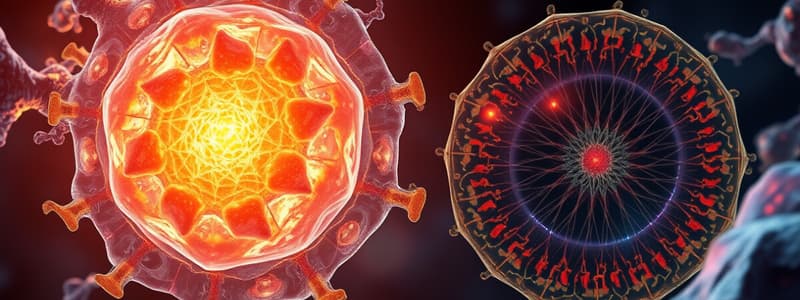Podcast
Questions and Answers
What is the primary function of precursor cells in hematopoiesis?
What is the primary function of precursor cells in hematopoiesis?
- To maintain the stem cell pool
- To undergo apoptosis
- To commit to forming a specific type of blood cell (correct)
- To self-renew indefinitely
Which of the following is a characteristic of hematopoietic stem cells (HSCs)?
Which of the following is a characteristic of hematopoietic stem cells (HSCs)?
- They are always committed to a specific lineage
- They can give rise to various blood cell types (correct)
- They are morphologically indistinguishable
- They can only undergo apoptosis
In the stochastic model of hematopoiesis, what determines the fate of hematopoietic stem cells?
In the stochastic model of hematopoiesis, what determines the fate of hematopoietic stem cells?
- Intrinsic genetic programming
- Pre-existing lineage specifications
- Random commitment to self-renewal or differentiation (correct)
- Environmental factors from the bone marrow
What role does the microenvironment in the bone marrow play according to the instructive model?
What role does the microenvironment in the bone marrow play according to the instructive model?
Which stem cell markers are specifically associated with committed myeloid progenitors?
Which stem cell markers are specifically associated with committed myeloid progenitors?
What is asymmetric division in the context of hematopoietic stem cells?
What is asymmetric division in the context of hematopoietic stem cells?
Which lineage is NOT derived from the common myeloid progenitor?
Which lineage is NOT derived from the common myeloid progenitor?
What is one possible outcome when hematopoietic stem cells undergo apoptosis?
What is one possible outcome when hematopoietic stem cells undergo apoptosis?
What morphological change occurs to the nucleus during cell differentiation?
What morphological change occurs to the nucleus during cell differentiation?
Which of the following is an intrinsic factor involved in hematopoiesis?
Which of the following is an intrinsic factor involved in hematopoiesis?
What effect do cytokines generally have on hematopoietic precursor cells?
What effect do cytokines generally have on hematopoietic precursor cells?
Which of the following indicates a decrease during cell maturation?
Which of the following indicates a decrease during cell maturation?
Which cytokine is known to exert a stimulatory effect?
Which cytokine is known to exert a stimulatory effect?
What happens to the size of the cytoplasm during differentiation?
What happens to the size of the cytoplasm during differentiation?
Which of the following is an extrinsic factor in hematopoiesis?
Which of the following is an extrinsic factor in hematopoiesis?
What role do cytokines play in apoptosis during hematopoiesis?
What role do cytokines play in apoptosis during hematopoiesis?
Which factor stimulates the formation of colony-forming units for granulocyte and monocyte/macrophage?
Which factor stimulates the formation of colony-forming units for granulocyte and monocyte/macrophage?
What is the primary role of interleukins in hematopoiesis?
What is the primary role of interleukins in hematopoiesis?
What happens to cells when they do not receive the appropriate cytokines?
What happens to cells when they do not receive the appropriate cytokines?
Which cytokine is known to stimulate the formation of CFU-G, a colony-forming unit for granulocytes?
Which cytokine is known to stimulate the formation of CFU-G, a colony-forming unit for granulocytes?
What is the role of KIT Ligand in hematopoiesis?
What is the role of KIT Ligand in hematopoiesis?
Which characteristic is true about early-acting multilineage growth factors?
Which characteristic is true about early-acting multilineage growth factors?
What natural process is involved in eliminating unwanted or abnormal cells?
What natural process is involved in eliminating unwanted or abnormal cells?
Which of the following statements about interleukins is true?
Which of the following statements about interleukins is true?
What type of cells does lymphopoiesis primarily produce?
What type of cells does lymphopoiesis primarily produce?
Which progenitor cell is responsible for generating mature T cells?
Which progenitor cell is responsible for generating mature T cells?
What is the final stage of cell development in megakaryopoiesis?
What is the final stage of cell development in megakaryopoiesis?
Which progenitor gives rise to both granulocytes and monocytes?
Which progenitor gives rise to both granulocytes and monocytes?
What is the role of CFU-pre-B in the hematopoietic process?
What is the role of CFU-pre-B in the hematopoietic process?
What is the primary biological activity of EPO?
What is the primary biological activity of EPO?
Which cell type does GM-CSF mainly target?
Which cell type does GM-CSF mainly target?
IL-6 is associated with which of the following biological activities?
IL-6 is associated with which of the following biological activities?
The primary source of IL-10 is derived from which of the following cell types?
The primary source of IL-10 is derived from which of the following cell types?
IL-2 is essential for the activation of which cell types?
IL-2 is essential for the activation of which cell types?
Which factor primarily stimulates the maturation of neutrophils?
Which factor primarily stimulates the maturation of neutrophils?
IL-12 is known for promoting differentiation toward which type of T cells?
IL-12 is known for promoting differentiation toward which type of T cells?
The biological activity of IL-15 includes promoting which type of cell proliferation?
The biological activity of IL-15 includes promoting which type of cell proliferation?
What is the primary role of IFN-α?
What is the primary role of IFN-α?
Which of the following cytokines is known to inhibit cytokine production?
Which of the following cytokines is known to inhibit cytokine production?
Flashcards are hidden until you start studying
Study Notes
Precursor Cells
- Committed to forming specific types of blood cells.
- Morphologically distinguishable and lineage-specific.
Model of Hematopoiesis
-
Pluripotent Hematopoietic Stem Cells (HSCs) differentiate into two main progenitors:
- Common Myeloid Progenitor → Granulocytic, Monocytic, Erythrocytic, and Megakaryocytic lineages.
- Common Lymphoid Progenitor → T, B, NK-lymphocytes, and Dendritic lineages.
-
Stem Cell Markers:
- CD 34 for Lymphoid & Myeloid precursors
- CD 33 & CD 38 for Committed Myeloid Progenitors
- CD 10 & CD 38 for Committed Lymphoid Progenitors
- CD 7 for T-lymphoid Progenitor cells
- CD 19 for B-lymphoid Progenitor cells
Possible Fates of Hematopoietic Stem Cells
- Self-renewal: HSCs replicate to maintain the stem cell pool.
- Differentiation: HSCs divide either symmetrically (both daughters differentiate) or asymmetrically (one daughter remains an HSC and the other differentiates).
- Apoptosis: HSCs die if they do not receive necessary signals.
Theories on Stem Cell Fate
- Stochastic Model: HSCs randomly choose between self-renewal or differentiation.
- Instructive Model: Decisions influenced by the bone marrow microenvironment.
- Current understanding suggests a combination of both models governs HSC fate.
Morphologic Changes During Differentiation
- Decrease in cell volume and alterations in nucleus-to-cytoplasm ratio (N:C).
- Nucleus changes: Loss of nucleoli, reduced size, chromatin condensation, and alterations in shape.
- Cytoplasm changes: Decreased basophilia and potential appearance of granules.
Signals from the Hematopoietic Inductive Microenvironment
- Intrinsic Factors: Gene expressions such as TAL1 and GATA2 regulate hematopoiesis.
- Extrinsic Factors: Growth factors and cytokines modulate HSC behavior.
- Regulatory Signaling Factors: Factors, including Notch-1 and Notch-2, enable HSC response to the microenvironment.
Hematopoietic Growth Factors and Cytokines
- Glycoproteins that regulate proliferation and differentiation of blood precursor cells.
- Key types include interleukins, lymphokines, monokines, and colony-stimulating factors (CSFs).
- Stimulatory cytokines: KIT ligand, FLT3 ligand, GM-CSF, IL-1, IL-3, IL-6, IL-11.
- Inhibitory cytokines: Growth factor-β, TNF-α, and interferons.
Roles of Cytokines
- Prevent apoptosis, promote cell division, and regulate differentiation into cell lineages.
- Apoptosis occurs when cells fail to receive necessary survival signals.
Colony-Stimulating Factors (CSFs)
- GM-CSF: Stimulates the formation of granulocyte and monocyte progenitors.
- M-CSF: Promotes monocyte differentiation.
- G-CSF: Encourages production of granulocyte colony-forming units.
Early-acting Multilineage Growth Factors
- KIT Ligand: Acts through KIT receptor; important for stem cell maintenance.
- FLT3 Ligand: Functions via FLT3 receptor for HSC proliferation.
Interleukins
- Proteins that facilitate hematopoiesis with synergistic effects with other cytokines; active at low concentrations.
Selected Hematopoietic Growth Factors or Cytokines
- EPO: Produced by kidney; stimulates erythroid progenitor growth and survival.
- G-CSF: Originates from endothelial cells; promotes neutrophil progenitor colonies.
- GM-CSF: Involved in T cell activation and antigen presentation.
Lymphopoiesis
- The production process of lymphocytes from Pluripotent HSCs.
Megakaryopoiesis
- The production pathway of platelets from HSCs through multiple progenitor stages.
Studying That Suits You
Use AI to generate personalized quizzes and flashcards to suit your learning preferences.




